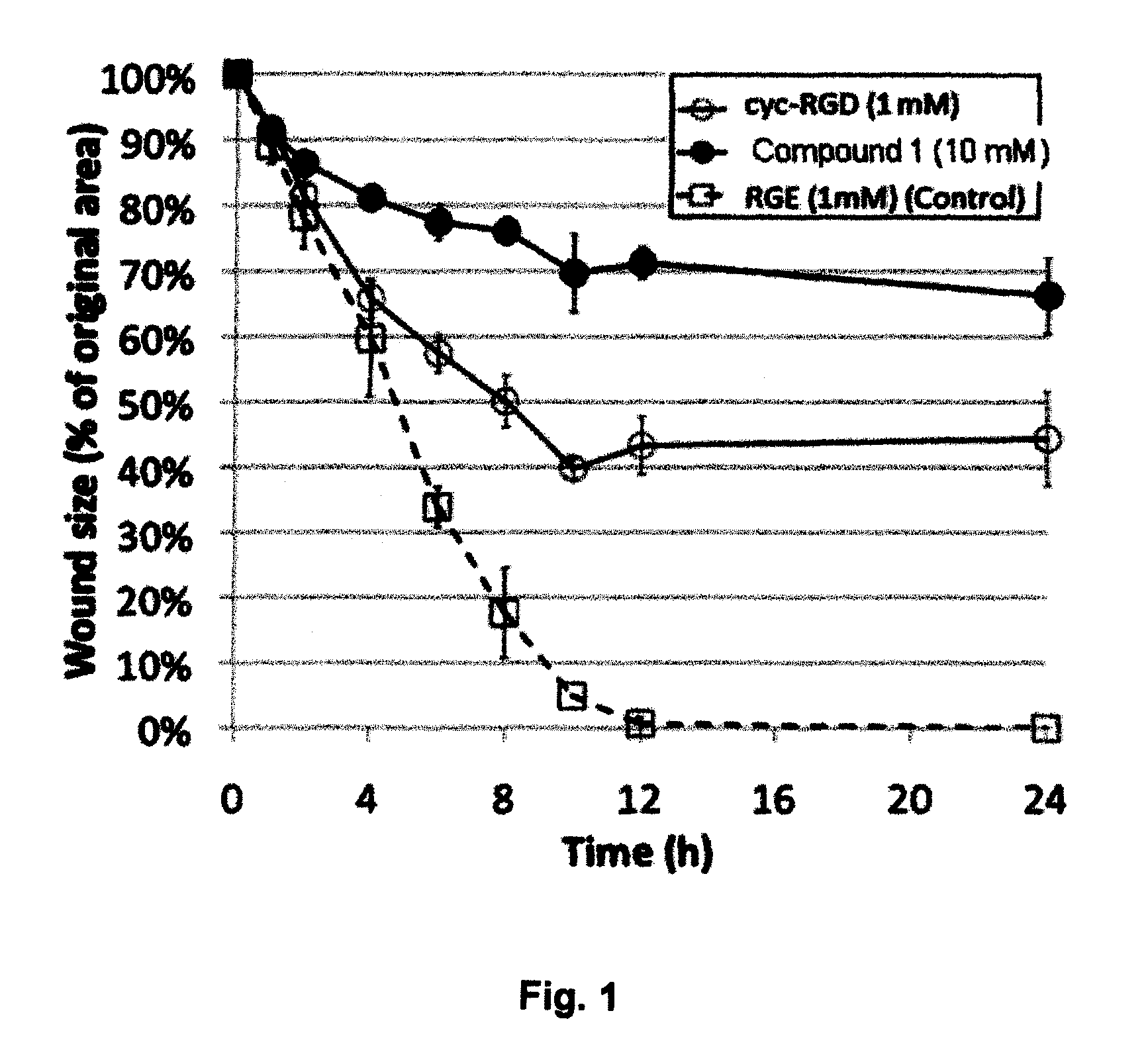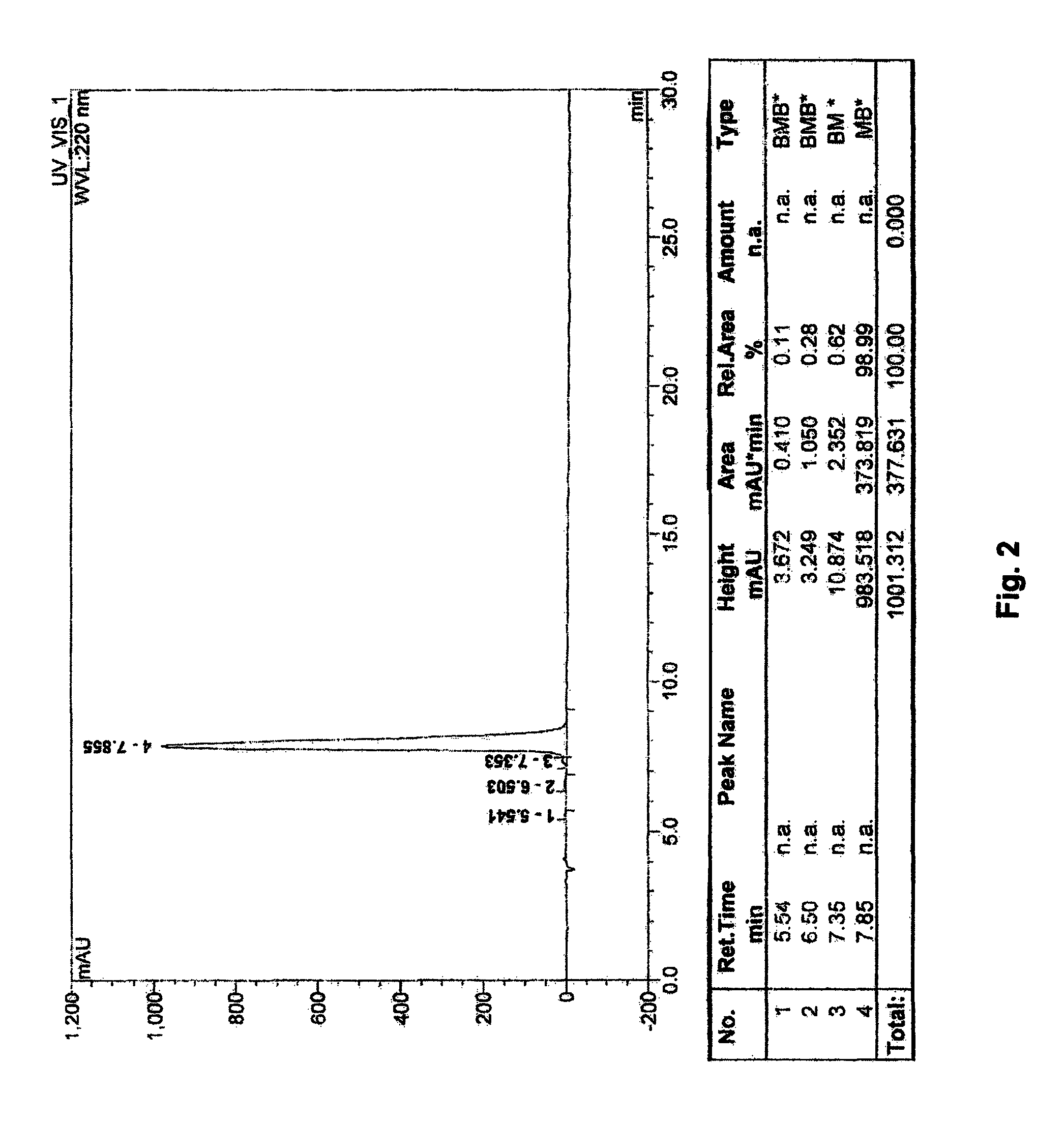Peptide compositions and therapeutic uses thereof
a technology of peptides and compositions, applied in the field of chemistry and medicine, can solve the problems of number of disease states, and achieve the effects of preventing blindness, reducing the number of disease states, and improving the quality of li
- Summary
- Abstract
- Description
- Claims
- Application Information
AI Technical Summary
Benefits of technology
Problems solved by technology
Method used
Image
Examples
example 1
Pharmaceutical Formulations
[0101]The following are examples of pharmaceutical formulations I-X, which contain R-G-Cysteic Acid Peptides of the present invention, such as any of those defined by General Formulas I-VII or any of Compounds 1-5 as described herein.
[0102]
Formulation IR-G-Cysteic Acid Peptide (RGCys-peptide)0.0001 mg to 10 gNaCl0.01 mg to 0.9 gWaterQS to 100.0 mLFormulation IIRGCysteic Acid Peptide (RGCys-peptide)0.0001 mg to 10 gEDTA0.001 mg to 100 mgNaCl0.01 mg to 0.9 gWaterQS to 100.0 mLFormulation IIIRGCysteic-peptide0.0001 mg to 10 gEDTA0.001 mg to 100 mgNaCl0.01 mg to 0.9 gCitric Acid0.0001 mg to 500 mgWaterQS to 100.0 mLFormulation IVRGCysteic-peptide0.0001 mg to 10 gNaCl0.01 mg to 0.9 gPhosphate Buffer topH = 3.0-9.0WaterQS to 100.0 mLFormulation VRGCysteic-peptide0.0001 mg to 10 gEDTA0.001 mg to 100 mgNaCl0.01 mg to 0.9 gPhosphate Buffer topH = 3.0-9.0WaterQS to 100.0 mLFormulation VIRGCysteic-peptide0.0001 mg to 10 gNaCl0.01 mg to 0.9 gBorate Buffer topH = 3.0-9...
example 2
Comparison of the PVD-Inducing Effects of RGD Peptides and Glycyl-Arginyl-Glycyl-Cysteic-Threonyl-Proline-COOH (GRG Cysteic Acid TP: Compound 1) (SEQ ID NO: 2) in Rabbits
[0103]In this example, the PVD-Inducing Effects of RGD Peptides and Glycyl-Arginyl-Glycyl-Cysteic-Threonyl-Proline-COOH(R-G-Cysteic Acid Peptide; GRG Cysteic Acid TP; Compound 1) (SEQ ID NO: 2) were compared in rabbits. The protocol for this study was as follows:
[0104]Protocol:
[0105]Animal Model[0106]a) 20 Male and Female Rabbits[0107]b) Weighing approximately 1.5-2.5 kg.[0108]c) Divide into 2 groups[0109]i) 10 Rabbits were injected intravitreally with 2.5% RGD solution at pH=6.5[0110]a) 10 Right Eye injected with 2.5% RGD solution[0111]b) 5 Left Eye used as BSS Control[0112]c) 5 Left Eyes injected with 2.5% RGD+0.02% EDTA at pH=6.5[0113]ii) 10 Rabbits were injected intravitreally with 2.5% R-G-Cysteic Acid solution at pH=6.5[0114]a) 10 Right Eye injected with 2.5% R-G-Cysteic Acid solution at pH=6.5[0115]b) 10 Left...
example 3
Safety Study of Multiple Injections of RGC Peptide Compound 1 (GRG Cysteic Acid TP (SEQ ID NO: 2)) in Rabbit Eyes
[0144]In this example, multiple injections of RGC Peptide Compound 1 were administered to the eyes of 5 Male and 4 Female New Zealand Rabbits weighing approximately 1.5-2.5 kg. and the eyes were examined as described in the following paragraphs.
[0145]The study then protocol was as follows:[0146]A) Baseline Examinations: At baseline the right and the left eyes of all 9 rabbits were examined slit lamp biomicroscopy and indirect ophthalmoscopy to confirm that no animals had pre-existing vitreoretinal abnormalities. In addition P-scan ultrasonography as well as ERG scans were performed on the left and right eyes of all 9 animals to obtain baseline readings.[0147]B) Experimental Treatments: All 9 Rabbits then received intravitreal injections of either RGC solution or saline (control). The treatment solutions were prepared as follows:[0148]RGC Solution: a 2.5 mg / 100 μl solution...
PUM
| Property | Measurement | Unit |
|---|---|---|
| diameter | aaaaa | aaaaa |
| diameters | aaaaa | aaaaa |
| time | aaaaa | aaaaa |
Abstract
Description
Claims
Application Information
 Login to View More
Login to View More - R&D
- Intellectual Property
- Life Sciences
- Materials
- Tech Scout
- Unparalleled Data Quality
- Higher Quality Content
- 60% Fewer Hallucinations
Browse by: Latest US Patents, China's latest patents, Technical Efficacy Thesaurus, Application Domain, Technology Topic, Popular Technical Reports.
© 2025 PatSnap. All rights reserved.Legal|Privacy policy|Modern Slavery Act Transparency Statement|Sitemap|About US| Contact US: help@patsnap.com



